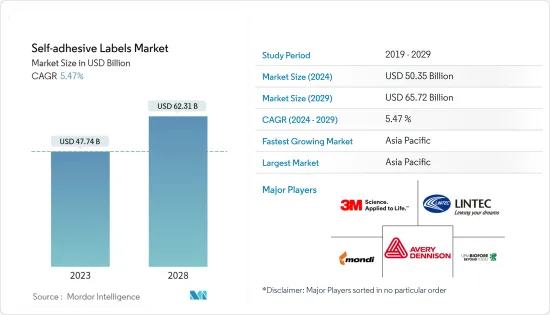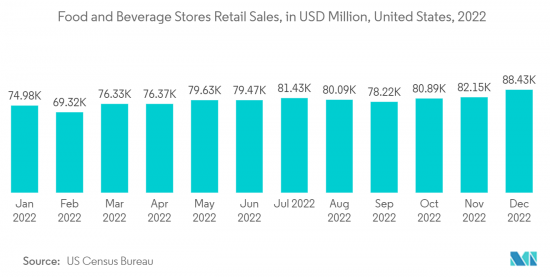 |
市場調査レポート
商品コード
1404400
自己粘着ラベル:市場シェア分析、産業動向と統計、2024~2029年の成長予測Self-adhesive Labels - Market Share Analysis, Industry Trends & Statistics, Growth Forecasts 2024 - 2029 |
||||||
● お客様のご希望に応じて、既存データの加工や未掲載情報(例:国別セグメント)の追加などの対応が可能です。 詳細はお問い合わせください。
| 自己粘着ラベル:市場シェア分析、産業動向と統計、2024~2029年の成長予測 |
|
出版日: 2024年01月04日
発行: Mordor Intelligence
ページ情報: 英文 120 Pages
納期: 2~3営業日
|
- 全表示
- 概要
- 目次
自己粘着ラベル市場規模は2024年に503億5,000万米ドルと推定され、2029年には657億2,000万米ドルに達すると予測され、予測期間中(2024-2029年)のCAGRは5.47%で成長する見込みです。

COVID-19の発生とそれに続く全国的な封鎖、製造活動やサプライチェーンの混乱、生産停止は、2020年の市場にマイナスの影響を与えました。しかし、2021年には状況が回復し始め、予測期間中の市場成長軌道を回復しました。
主なハイライト
- 急成長するeコマース産業と飲食品消費の増加が市場の需要を牽引するとみられます。
- 逆に、政府規制の増加やライナーレスラベルのような代替品の利用可能性が市場成長の妨げになると思われます。
- 持続可能な慣行へのシフトに伴うバイオベースの自己接着剤への需要の増加は、調査された市場にとって好機となるであろう。
- アジア太平洋地域が大きなシェアを占めており、予測期間中もその優位性は続くとみられます。
自己粘着ラベル市場の動向
飲食品業界からの需要増加
- 自己粘着ラベルは、飲食品パッケージブランドの美的特性を向上させることで知られています。パッケージングとラベリングは、消費者の注意を引くのに役立つため、製品の販売に不可欠な役割を果たしています。マーケティング担当者は主に、潜在的な消費者に製品の購入を促すためにラベルを使用します。ラベルは、パッケージや製品の使用方法、輸送方法、リサイクル方法、廃棄方法を伝えます。
- ラベリングは、飲食品分野において、成分情報、製品識別、注意喚起を提供します。自己粘着ラベルメーカーは、粘着剤が食品成分に影響を与えないよう、法的要件を遵守しなければならないです。
- さらに、世界の食品包装市場は今年末までに約3,620億米ドル、2027年には4,636億5,000万米ドルに達すると推定されています。したがって、食品包装市場の成長は、今後数年間で自己粘着ラベルの需要を増加させると思われます。
- 米国商務省によると、2023年1月の小売店および食品サービス店の総売上高は782億7,000万米ドルでした。一方、2022年1月には749億8,000万米ドルでした。約4.39%の大幅な増加があり、さらに増加すると予想されます。
- さらに、さまざまな食品加工企業が包装食品事業の新工場や能力拡張に投資しています。生産連動奨励金(PLI)制度の下、インド政府はヒンドスタン・ユニリーバ、アムル、ネスレ、ダブール、ITC、パール、ブリタニアなど60社の加工食品会社から投資提案を受けました。
- このように、上記の要因は予測期間中に自己粘着性ラベルの需要を増加させると思われます。

アジア太平洋が市場を独占する
- アジア太平洋地域は市場を独占しており、予測期間中に大きく成長すると予想されます。中国、インド、日本、韓国などの国々でパッケージング、エレクトロニクス、パーソナルケア産業が成長しており、自己粘着ラベルの消費が増加しています。
- 2022年、中国からのパーソナルケアと化粧品の輸出総額は56億3,000万米ドルであったが、2021年には48億5,000万米ドルでした。前年比16.08%増であり、今後さらに増加すると予想されます。
- 中国はエレクトロニクス生産の最大の拠点です。スマートフォン、テレビ、その他の個人用機器などの電子製品は、エレクトロニクスの中で最も高い成長を記録しました。同国はエレクトロニクスの国内需要に応えるとともに、エレクトロニクス生産物を他国に輸出しています。中産階級の可処分所得の増加に伴い、エレクトロニクス製品の需要は増加すると予測されています。
- ZEVIによると、アジアのエレクトロニクス市場は2021年に3兆1,100億ユーロ(3兆6,740億米ドル)に達し、10%増加しました。2022年の市場は13%増加し、2023年の成長率は7%と推定されます。中国市場は世界最大で、先進工業国の合計市場よりも大きいです。さらに、中国の電子産業は2022年に14%拡大し、2023年には8%の成長が見込まれています。
- 自己粘着ラベルは、各国に輸出入される医薬品や医療機器の包装に広く使用されています。インド政府によると、インドの医薬品産業市場規模は2030年までに1,300億米ドルに達すると予想されています。インドは200カ国以上に医薬品を供給しており、今後もそうなる可能性があります。
- インド第5位の包装産業は、経済成長、人口ボーナス、eコマースの成長に牽引され、大きく成長しています。例えば、2022年1月、Flipkartは食料品サービスを拡大し、インドの1800都市にサービスを提供すると発表しました。2022年6月、アマゾン・インディアはマニプール州政府企業であるManipur Handloom &Handicrafts Development Corporation Limited(MHHDCL)とMoUを締結し、州内の職人や織工の成長を支援します。
- このような要因は、予測期間中に調査された市場の需要を促進すると思われます。
自己粘着ラベル産業の概要
調査対象市場は細分化されています。市場の主要企業には、3M、Avery Dennison Corporation、UPM、Mondi、LINTEC Corporationなどが挙げられます(順不同)。
その他の特典:
- エクセル形式の市場予測(ME)シート
- 3ヶ月間のアナリスト・サポート
目次
第1章 イントロダクション
- 調査の前提条件
- 調査範囲
第2章 調査手法
第3章 エグゼクティブサマリー
第4章 市場力学
- 促進要因
- 急成長するeコマース産業
- 飲食品業界からの加工食品需要の増加
- その他の促進要因
- 抑制要因
- 政府規制の増加
- その他の阻害要因
- 業界バリューチェーン分析
- ポーターのファイブフォース分析
- 供給企業の交渉力
- 消費者の交渉力
- 新規参入業者の脅威
- 代替品の脅威
- 競合の程度
第5章 市場セグメンテーション(金額ベース市場規模)
- 接着剤タイプ
- ホットメルト
- エマルジョンアクリル系
- 溶剤
- 面材
- 紙
- プラスチック
- ポリプロピレン
- ポリエステル
- ビニール
- その他プラスチック
- 用途
- 飲食品
- 医薬品
- 物流・輸送
- パーソナルケア
- 耐久消費財
- その他の用途
- 地域
- アジア太平洋
- 中国
- インド
- 日本
- 韓国
- その他アジア太平洋地域
- 北米
- 米国
- カナダ
- メキシコ
- 欧州
- ドイツ
- 英国
- フランス
- イタリア
- その他欧州
- 南米
- ブラジル
- アルゼンチン
- その他南米
- 中東・アフリカ
- 南アフリカ
- サウジアラビア
- その他中東とアフリカ
- アジア太平洋
第6章 競合情勢
- M&A、合弁事業、提携、協定
- 市場シェア(%)**/ランキング分析
- 主要企業の戦略
- 企業プロファイル
- 3M
- Asteria Group
- Avery Dennison Corporation
- CPC Haferkamp GmbH & Co. KG
- Fuji Seal International, Inc.
- H.B. Fuller Company
- HERMA
- LECTA
- LINTEC Corporation
- Mondi
- Optimum Group
- Symbio, Inc.
- Thai KK Group
- UPM
第7章 市場機会と今後の動向
- バイオベースの自己粘着ラベルへの焦点のシフト
- その他の機会

The Self-adhesive Labels Market size is estimated at USD 50.35 billion in 2024, and is expected to reach USD 65.72 billion by 2029, growing at a CAGR of 5.47% during the forecast period (2024-2029).
The COVID-19 outbreak and the subsequent nationwide lockdowns, disruption in manufacturing activities and supply chains, and production halts negatively impacted the market in 2020. However, the conditions started recovering in 2021, restoring the market's growth trajectory for the forecast period.
Key Highlights
- The rapidly growing e-commerce industry and increased consumption of food and beverage products will likely drive the market demand.
- Conversely, increasing government regulations and the availability of substitutes like linerless labels will likely hinder market growth.
- The increasing demand for bio-based self-adhesives with a shift to sustainable practices will act as an opportunity for the market studied.
- Asia-Pacific dominated the market with a significant share and is expected to continue its dominance during the forecast period.
Self Adhesive Labels Market Trends
Increasing Demand from the Food and Beverage Industry
- Self-adhesive labels are known to improve the aesthetic characteristics of food and beverage packaging brands. Packaging and labeling play an essential role in the sale of products, as they help grab consumers' attention. Marketers mainly use them to encourage potential consumers to purchase the product. Labels communicate how to use, transport, recycle, and/or dispose of the package or product.
- Labeling provides ingredient information, product identification, and cautionary notifications in the food and beverage sector. Self-adhesive label manufacturers must comply with the legal requirements to ensure the adhesive does not affect the food ingredients.
- Furthermore, the global food packaging market is estimated to reach around USD 362 billion by the end of this year and USD 463.65 billion in 2027. Thus, the growing food packaging market will increase the demand for self-adhesive labels in the coming years.
- According to the US Department of Commerce, in January 2023, the total sales of retail and food services stores stood at USD 78.27 billion. In contrast, in January 2022, the figure stood at USD 74.98 billion. There is a substantial increase of approximately 4.39%, which is expected to increase further.
- Moreover, various food processing companies invest in new plants and capacity expansions of the packaged food business. Under the Production Linked Incentive (PLI) scheme, the Indian government received investment proposals from 60 processed food companies, including Hindustan Unilever, Amul, Nestle, Dabur, ITC, Parle, and Britannia.
- Thus, the abovementioned factors will likely increase the demand for self-adhesive labels in the forecast period.

Asia-Pacific to Dominate the Market
- Asia-Pacific dominated the market and is expected to grow significantly over the forecast period. With the growing packaging, electronics, and personal care industries in countries like China, India, Japan, and South Korea, the consumption of self-adhesive labels is increasing.
- In 2022, the total export of personal care and cosmetics from China stood at USD 5.63 billion; in 2021, the figure was USD 4.85 billion. There is an increase of 16.08% compared to the previous year, which is expected to increase further.
- China is the largest base for electronics production. Electronic products, such as smartphones, TVs, and other personal devices, recorded the highest growth in electronics. The country serves the domestic demand for electronics and exports electronic output to other countries. With an increase in disposable incomes of the middle-class population, the demand for electronic products is projected to increase.
- According to ZEVI, the Asian electro market reached EUR 3.11 trillion (USD 3.674 trillion) in 2021, a 10% rise. The market increased by 13% in 2022 and estimated a 7% growth rate for 2023. China's market is the largest in the world, even larger than the combined markets of all industrialized countries. Additionally, the Chinese electronic industry expanded by 14% in 2022, and the sector is expected to grow by 8% in 2023
- Self-adhesive labels are widely used in packaging medicines and medical equipment imported or exported to different countries. According to the government of India, the Indian pharma industry market size is expected to reach USD 130 billion by 2030. India provides pharmaceutical products to more than 200 countries and may continue to do so.
- India's fifth-largest packaging industry is growing significantly, led by economic growth, demographic dividend, and growing e-commerce. For instance, in January 2022, Flipkart announced expanding its grocery services and will offer services to 1,800 Indian cities. In June 2022, Amazon India signed an MoU with Manipur Handloom & Handicrafts Development Corporation Limited (MHHDCL), a Government of Manipur Enterprise, to support the growth of artisans and weavers across the state.
- Such factors will likely drive the market demand studied during the forecast period.
Self Adhesive Labels Industry Overview
The market studied is fragmented. Some key players in the market include (not in any particular order) 3M, Avery Dennison Corporation, UPM, Mondi, and LINTEC Corporation, among others.
Additional Benefits:
- The market estimate (ME) sheet in Excel format
- 3 months of analyst support
TABLE OF CONTENTS
1 INTRODUCTION
- 1.1 Study Assumptions
- 1.2 Scope of the Study
2 RESEARCH METHODOLOGY
3 EXECUTIVE SUMMARY
4 MARKET DYNAMICS
- 4.1 Drivers
- 4.1.1 Rapidly Growing E-commerce Industry
- 4.1.2 Increasing Demand for Packed Foods from Food and Beverage Industry
- 4.1.3 Other Drivers
- 4.2 Restraints
- 4.2.1 Increasing Government Regulations
- 4.2.2 Other Restraints
- 4.3 Industry Value Chain Analysis
- 4.4 Porter's Five Forces Analysis
- 4.4.1 Bargaining Power of Suppliers
- 4.4.2 Bargaining Power of Consumers
- 4.4.3 Threat of New Entrants
- 4.4.4 Threat of Substitute Products and Services
- 4.4.5 Degree of Competition
5 MARKET SEGMENTATION (Market Size in Value)
- 5.1 Adhesive Type
- 5.1.1 Hot-melt
- 5.1.2 Emulsion Acrylic
- 5.1.3 Solvent
- 5.2 Face Material
- 5.2.1 Paper
- 5.2.2 Plastic
- 5.2.2.1 Polypropylene
- 5.2.2.2 Polyester
- 5.2.2.3 Vinyl
- 5.2.2.4 Other Plastics
- 5.3 Application
- 5.3.1 Food and Beverage
- 5.3.2 Pharmaceutical
- 5.3.3 Logistics and Transport
- 5.3.4 Personal Care
- 5.3.5 Consumer Durables
- 5.3.6 Other Applications
- 5.4 Geography
- 5.4.1 Asia-Pacific
- 5.4.1.1 China
- 5.4.1.2 India
- 5.4.1.3 Japan
- 5.4.1.4 South Korea
- 5.4.1.5 Rest of Asia-Pacific
- 5.4.2 North America
- 5.4.2.1 United States
- 5.4.2.2 Canada
- 5.4.2.3 Mexico
- 5.4.3 Europe
- 5.4.3.1 Germany
- 5.4.3.2 United Kingdom
- 5.4.3.3 France
- 5.4.3.4 Italy
- 5.4.3.5 Rest of Europe
- 5.4.4 South America
- 5.4.4.1 Brazil
- 5.4.4.2 Argentina
- 5.4.4.3 Rest of South America
- 5.4.5 Middle-East and Africa
- 5.4.5.1 South Africa
- 5.4.5.2 Saudi Arabia
- 5.4.5.3 Rest of Middle-East and Africa
- 5.4.1 Asia-Pacific
6 COMPETITIVE LANDSCAPE
- 6.1 Mergers and Acquisitions, Joint Ventures, Collaborations, and Agreements
- 6.2 Market Share (%)**/Ranking Analysis
- 6.3 Strategies Adopted by Leading Players
- 6.4 Company Profiles
- 6.4.1 3M
- 6.4.2 Asteria Group
- 6.4.3 Avery Dennison Corporation
- 6.4.4 CPC Haferkamp GmbH & Co. KG
- 6.4.5 Fuji Seal International, Inc.
- 6.4.6 H.B. Fuller Company
- 6.4.7 HERMA
- 6.4.8 LECTA
- 6.4.9 LINTEC Corporation
- 6.4.10 Mondi
- 6.4.11 Optimum Group
- 6.4.12 Symbio, Inc.
- 6.4.13 Thai KK Group
- 6.4.14 UPM
7 MARKET OPPORTUNITIES AND FUTURE TRENDS
- 7.1 Shifting Focus Toward Bio-based Self-adhesive Labels
- 7.2 Other Opportunities
